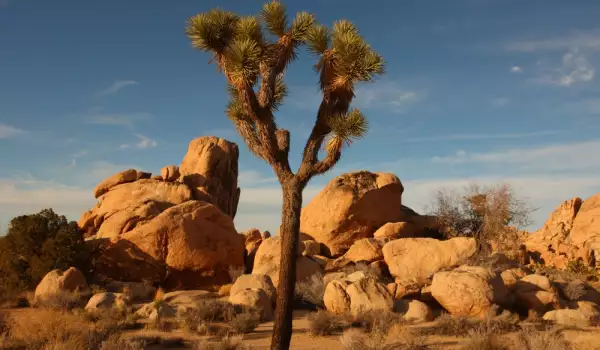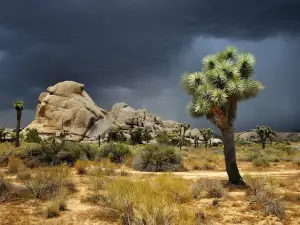Joshua Tree National Park

Joshua Tree National Park is located in California. The area on which today the national park extends was inhabited by people already in the epoch of the Pleistocene, ten thousand years ago. The conditions were completely different back then - at that time the region was wetter and colder, mammoths, mastodons, camels and bison lived here. It is believed that the area where the park is today, people of the culture Pinto were living.
Joshua Tree National Park has received National Park status in 1994. The park enjoys a great popularity mostly because of its immediate proximity to Los Angeles. Despite all its popularity, however, three quarters of the park is inaccessible to tourists.
Joshua Tree Park has desert status. It is located at the intersection of two giant North American deserts - the desert Sonora and the Mojave Desert. Eastern and southern areas of the park have plant species typical of the Sonoran desert, which is known for its chaparral. Western areas of the park are located at higher elevations, so they get more coolness and moisture. That is because this area has many Yukon trees.
In the central part of the park are amazing rock formations that actually attract a huge influx of tourists. In the park there is a well maintained network of hiking trails, which are available on foot and on horseback. The total length of trails is about one hundred kilometers. This park attracts many lovers of horse trekking and hiking. Each year the park attracts over one million people worldwide. Within the park there are no hotels and no gas stations, in order to keep nature pristine. The park has no restaurants and no souvenir shops. Rather, the Joshua Tree Park has places for camping.

The park has five oases around which many birds gather. During spring a huge amount of flocks of migration birds come here from across the Pacific Ocean. Nearby grow cacti and the cosmetic industry’s jojoba.
When the period of spring rains starts, the desert begins to bloom, which is a really impressive sight. At the time you will see flowering lavender, indigo bush and primula. Cacti puzzle glances with the most amazing colors. Joshua Tree, after which is named the national park, is known for its unusual lilies. Their dazzling white colors can be seen very rarely, as the season of flowering for the tree changes over the years. Generally this occurs between February and April.
In the park there are over five hundred archaeological sites and eighty-eight historic buildings.
The park has a huge amount of reptilians who love the superior climate of this part of the country. In a region in which humidity is rare, but food is hard to find, reptiles are the real kings of the park.
Unlike mammals and birds, reptiles do not need water to cool down in warm days, so lack of water affects them less drastically. Reptiles get all the water they need from their prey, which they capture. Many of the reptiles in the park Joshua Tree do not drink water throughout their lives. In the park live desert tortoises from the Mojave, it has Eighteen species of lizards and twenty-five species of snakes. Geckos, iguanas, leopard lizards, lizards and other interesting representatives of the Reptilians can be seen in the park. Despite the drought-afflicted conditions of the park, within it live fifty-two mammal species. In the park can be found mountain sheep and deer.















